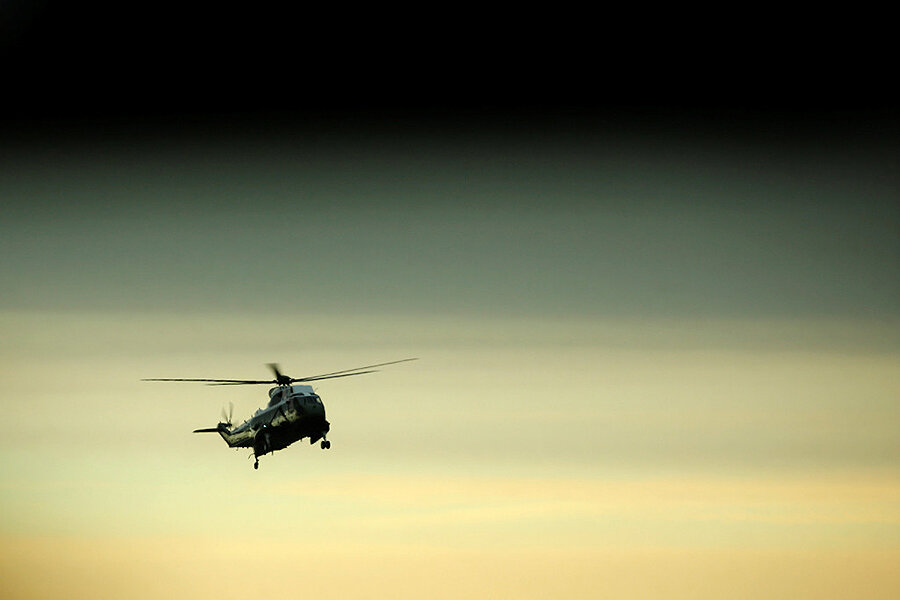Al Qaeda raid in Yemen: Civilians 'likely killed' in Trump's first counterterror op, Pentagon says
Loading...
A weekend raid in Yemen's Bayda province against Al Qaeda, the first counter-terrorism operation approved by President Trump, which resulted in the death of one American commando and 14 militants, "likely killed" civilian noncombatants, the US military said Wednesday.
On Sunday, Mr. Trump claimed that the operation against Al Qaeda had been a success, saying that SEAL Team 6, along with elite soldiers from the United Arab Emirates, had captured "important intelligence that will assist the US in preventing terrorism against its citizens and people around the world."
Initially, Pentagon officials had claimed there were no civilian casualties involved with the operation. But pictures of bodies began to circulate on social media in the aftermath of the raid, and on Wednesday, the Pentagon said that civilians, including children, had likely been killed.
The mission reportedly had two aims: to detain Yemeni tribal leaders who had been working with Al Qaeda and to acquire phones and laptops for intelligence purposes. Plans for the raid had been reviewed and postponed late in the Obama administration, partially because the next moonless night, the perfect time to conduct a commando raid, would not come until after the end of his term, according to The New York Times.
"We really struggled with getting the White House comfortable with getting boots on the ground in Yemen," a former senior defense official familiar with prior operations in Yemen told The Washington Post. "Since the new administration has come in, the approvals [at the Pentagon] appear to have gone up." The official called this weekend's raid "overdue."
Yet another military official expressed doubt that the "minimal" on-the-ground surveillance in the area had adequately prepared the commando team for the operation.
"The decision was made ... to leave it to the incoming administration, partly in the hope that more and better intelligence could be collected," that official told Reuters.
Once on the ground, the team encountered unexpectedly large resistance from Al Qaeda fighters manning a base fortified with landmines and snipers. The base had also been tipped off to their arrival, possibly by the noise of drones flying lower than usual prior to the operation, according to The New York Times.
The unexpectedly intense fighting involved a hard landing of a $70 million MV-22 Osprey aircraft that had to be destroyed and led to the death of Chief Special Warfare Operator William "Ryan" Owens.
According to the Pentagon, 14 Al Qaeda fighters were killed in the operation. The exact number of civilian casualties is still under investigation, though medics at the scene said that 30 people had been killed, including 10 women and children.
Among the reported civilian casualties was eight-year-old Nawar Al-Awlaki, the daughter of US-born Al Qaeda propagandist Anwar Al-Awlaki, who was killed during a drone strike in 2011. Nasser Al-Awlaki, Nawar's grandfather, said that he did not think that her death was intentional.
The Yemeni government, now in exile as the country's nearly two-year civil war continues, was sending weapons to his relatives in order to fight Houthi rebels, Al-Awlaki told The Guardian.
"If the Americans assumed that those arms were going to the hands of al-Qaida or something, I don't know," he said. "I cannot understand why the Americans use this big commando strike, which is similar to what happened to Osama bin Laden, in a small village in Yemen."
People who sprang up to fight were not doing so because they were Al Qaeda fighters, but because they were defending themselves, including women, he said.
According to US officials, however, the women fighting back had taken up positions indicative of some kind of combat training.
"There were a lot of female combatants who were part of this," Defense Department spokesman Capt. Jeff Davis told reporters, according to The New York Times. "We saw during this operation as it was taking place that female fighters ran to pre-established positions as though they'd been trained to be ready and trained to be combatants."
This article contains material from Reuters.








